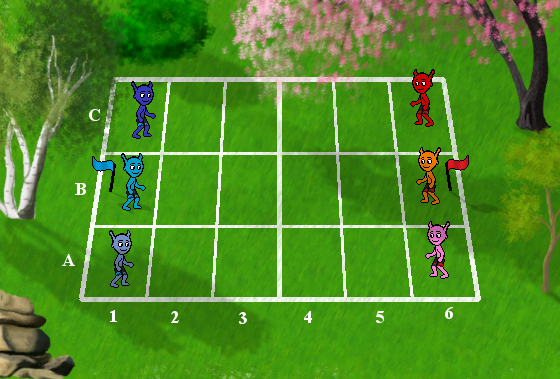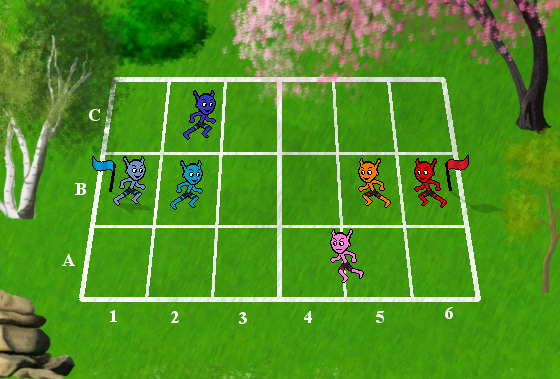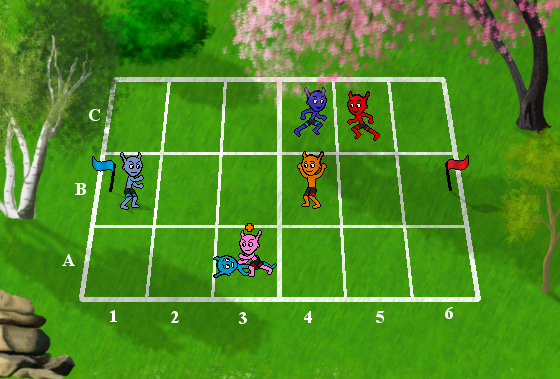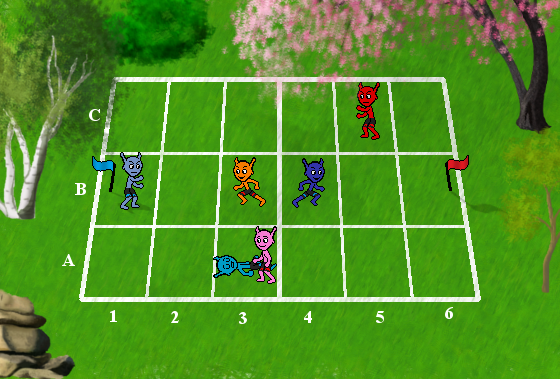Rules and how it will work
The game is Capture the Flag. The players are split in teams, working against each other to get the other team's flag. (Ok, everyone knows how that works.)
Fair warning, the rules are a veritable wall of text, but
I promise it's far simpler than it looks. If you jump down to
post 3 you can get an idea for how it works. Most of the math stuff will be handled on the GM's end. Of course knowing the rules certainly makes it a lot easier for you to win.
Character types
There are three kinds of goblins, each with a corresponding feat; those with an affinity towards attacking, those with a more passive defensive stature and those who think things through before acting. Or in simpler terms:

- Attacker. Gets +5% when attempting to dodge. Can sprint on opponents' half. (In combat, attackers have +1 attack instead.)

- Defender. Gets +10% when Guarding or Tackling on own half. (In combat, defenders have +1 defense instead.)

- Strategist. Gets more avaliable skills. Has a special move: Cheer. Cheering gives +5% bonus to a teammate one square away. Should that player win a tussle, the strategist gains 1 exp.
Game procedure
Each player sends two moves by PM to the match referee for each turn. In some cases, a player might be allowed less or more than two moves, but that is explained below. All actions happen simultaneously, so there is no bonus for posting quickly. When there are conflicting moves, random die roll determines the order of turns or target of attacks unless the players specify.
A team captain is chosen by each team. This player can send in "spare turns" for their teammates. One per turn of these may replaced a missed turn by a teammate.
Game terms
- Tussle, pin, dodge
A tussle is a physical battle between two players of opposing teams. The players either aim to pin the opponent, or dodge them. The tussle is resolved by our old friend, the d20. Both players have an equal chance (10 to 10) of coming out the winner, but as many different bonuses are applied, the odds change. Bonuses are addative and can cancel each other out.
Example:
Red Team Attacker Sprints forward on blue team's half, but a Blue Team Defender moves in the way and Guards. Blue Defender tries to pin, while Red Attacker tries to Dodge. Defenders get a 10% bonus to Guard on their own half, but Attackers get a 5% bonus while dodging. However, being caught while sprinting incurs a 10% penalty. Blue's bonus is 10%, while Red's net penalty is 5%. All in all, this means Blue gets a 15% bonus, meaning they win on 13 numbers versus Red's 7.
In practise matches, the winner of a tussle wins 1 point for their team and 1 exp.
If the winner was dodging, the winner may take the rest of their moves that turn. The loser is distracted for this turn, but can move normally again next turn.
If the winner was trying to pin their turn ends, the loser is distracted at the start of next turn, and must use their first move to get up. If a player is pinned on the opponents' half, they must instead use the first move to warp back to a square of their choice in the back row of their own half. (It's magic. Don't ask.)
Multiple targets: If more than one opponent is avaliable when a tussle starts, the opponents that are doing agressive actions (Guarding, landing a tackle) are targetted before passive actions (running, sprinting, moving part of tackle, cheering or standing around). If several targets have the same priority (like two guarders in the same square) the initiator gets to choose (random if they don't choose).
Multiple attackers: If several players are attacking the same square, the order is decided by the attackers. In case they don't specify, they go in order of turn sent.
Moves
You make two moves each turn, with some exceptions. The basic moves are as follows:
- Run.
Move one square on the field. Diagonal running is not allowed. If caught in a tussle, the runner will try to dodge. A running player does not engage in a tussle with a running opponent player.
- Sprint. (Full turn action)
Allows 3 squares of movement. Hovever, sprinting makes it harder to stay alert, so a sprinting player suffers a -10% penalty if they should end up in a tussle. Furthermore, the player takes a -5% penalty to tussles on the next turn due to fatigue, and cannot sprint again for the next 2 turns.
Players may only take the majority of a Sprint action on their own half (except for Attackers).
- Guard
Defend the square you are in. If an opponent enters your square this move, you engage them in a tussle, attempting to pin them. While Guarding, the player negates the opponent's Tackle bonus. However, standing around too long will make your legs stiff, so a player that takes multiple Guard actions in one square takes a cumulative -5% penalty for each Guard action after the first. This penalty is negated after the player moves to another square.
- Tackle
A tackle is one or two Run actions ending with an attempt to pin the opponent in the target square. The tackling player gets a +10% bonus per square moved in the resulting tussle. However, should there be no opponent at the end of the tackle, the player loses the rest of the turn, and suffers a -5% penalty on tussles next turn. Also, should the tackling player be engaged before they reach the target square, they suffer a -10% penalty in that tussle.
When tackling a player that is moving away from the target square on the same turn as the tackle lands, the tackle hits if the target moves towards the tackler. It misses if the target moves straight away from the tackler. If the target moves sideways, there is a 50% chance the tackle hits.
- Cheer
A strategist only move that gives a teammate within 1 square a +5% bonus. The recipient only receives the bonus so long as they remain within the Strategist's cheer range. (See Cheer Range feat below)
- Take the flag
If a player is in the same square as the opponents' flag, they may pick it up as one standard move. You may not pick up your own flag.
- Spacing out
If a player doesn't send a turn and has left no notice, they are spacing out. While spacing out, player recieves a 10% penalty to tussles.
Also, if you space out too much without having left a notice, you may be disallowed to join matches in the future.
Other things:
- Carrying the flag
While carrying the flag, the player cannot Guard or Tackle and does not gain bonuses from skills or feats that doesn't concern flag carrying. If the flag carrier loses a tussle and is pinned, the flag is dropped. If no teammates are left standing in the square, the flag returns to its starting position. (It's a magic flag.) The flag may be dropped as a free action.
If the flag is carried back to your own half, the team gets 5 points! All players in the team that participated in the attack run (determined by referee) gets 3 exp. Additionally, anyone earning xp for participating in a flag run must return to their own half before touching the flag or earning xp as part of a flag capture again.
The game cannot end while a member of the losing team has the flag.
- Teammates in same square
Apart from being a pain to draw for the referee, teammates in the same square all get a -5% penalty per extra player in the square due to limited mobility. This doesn't apply if the teammate is already pinned (or unconcious).
- Respawning
After being pinned on the opponent's half a player must respawn in their home/back row. They cannot respawn in a square with an opponent in it at the end of the previous turn.
- Scoring
Points are awarded for bringing the flag back to your own half of the pitch. Points are also awarded for other game actions, since these are practise games. The match ends when the preset match target is reached (this might vary as I experiment with the settings).
- 5 points for bringing the opponent's flag to your half.
- 1 point for winning a tussle against an opponent.
- 1 point for advancing all the way to the opponent's flag square. You have to return to your own half before you can score another point like this.
- Experience
In practise matches, players get:
- 1xp for winning a tussle
- 1xp for sending an opponent back to their back row
- 3xp for participating in a successful flag capture
- 1xp for each row into the opponents side they advance. The maximum row reached is reset when/if the opponent flag is successfully captured.
- 1xp for being on the winning team.
- 1xp for cheering on a teammate as they win a tussle.
- "Camping"
Sometimes, it might be strategically important to keep a player out of the action by attacking them repeatedly. In order to prevent this from being a way to gain exp and points, there are two restrictions.
- After a player wins a tussle against an opponent, one of them has to leave that square before the winner can get exp or team points for winning a tussle against that same opponent again.
- Winning a tussle against someone "standing up" after being pinned does not yield exp or team points.
Skills and Experience
When you gain enough experience to gain a level, you can choose one level of a skill or feat. Skills are special moves you can do as an action or part of an action. Feats are permanent improvements to your character.
Some skills and feats have class level prerequisites. Also, new skills and feats might become available as the game progresses (or when I get a good idea).
Class levels
You have one class level when you start, and gain another every 10th level. Each class level corresponds to a feat or skill, listed here. (You need to have the lower tiers to pick the higher tier for each class, naturally.)
- Attacker 1: +5% to dodge, may sprint on opponents half. In combat, this is substituted for +1 ATK.
- Attacker 2 (Striker): +5% to dodge and tackle on the opponent's side. In combat, substituted for another +1 ATK.
- Defender 1: +10% to tackle and guard on own half. In combat, this is substituted for +1 DEF.
- Defender 2 (Protector): +5% in tussles against a flag carrier. In combat, substituted for another +1 DEF.
- Strategist 1: Skill: Cheer. Adds a 5% bonus to a teammate in an adjacent square for their current action.
- Strategist 2 (Tactician): Skill: Boost. Once per game. Boosts a teammate in cheer range to allow them to take an extra action that turn. In combat, the boost instead gives +1 HP to the target.
Feats
- Improved dodging (5 levels). For each level, the player gains a 5% bonus when Dodging in a tussle.
- Improved guarding (5 levels). For each level, the player gains a 5% bonus to tussles when Guarding.
- Improved tackling (5 levels). For each level, the player's tackle bonus is increased by 5%.
- Teamwork (3 levels). Each level reduces your penalty for being in the same square as a teammate by 5%.
- Sprint awareness (3 levels). Each level reduces the penalty to tussles entered while sprinting by 5%. The third level allows your Nimble bonus to count while sprinting.
- Banner bearer (ATT 1 or STG 1, 5 levels). Each level allows 5% of total bonus from other skills/feats while carrying the flag.
- Banner guardian (DEF 1, 2 levels). Allows you to Guard (Lv1) and Tackle (Lv2) while carrying the flag.
- Nimble (ATT 1, 3 levels). Use your speed to gain a +10% to dodge against stationary (guarding) opponents when you are moving. Bonus doesn't apply while sprinting.
- Sprint endurance (ATT 1, 2 levels). First level removes the penalty on the turn after sprinting. Second level reduces the "cooldown" on Sprint to one turn.
- Tackle stamina (DEF 1, 2 levels). First level removes the penalty on the round after missing a tackle. Second level removes the penalty for being caught in a tussle on the moving part of a tackle.
- Cheer effectiveness (STG 1, 3 levels). Each level increases the bonus for Cheering by 5%.
- Cheer range (STG 1, 3 levels). Increases the range of Cheering. Target has to be in the squares indicated by T, when the cheerer is at C:
Code: Select all
Level 0 Level 1 Level 2 Level 3
T TTT
T TTT TTT TTTTT
TCT TCT TTCTT TTCTT
T TTT TTT TTTTT
T TTT
- Cheer stacking (STG 1, 3 levels). Each level allows 5% of the player's Cheering bonus to stack with other strategist's Cheering bonus on the target, if ALL strategists have it.
- Lasting Cheer duration (STG 2, 2 levels). Each level adds one action's worth of duration to the Lasting Cheer skill.
- Extra Boosts (STG 2, 4 levels). Each level allows another use of the Boost skill per game.
- Improved Reflexes (ATT 2, 1 level). This feat allows the bonus from Nimble to count even if the player is standing still.
Skills
- Read opponent (STG, 5 levels). This skill lets the user condition their move to the move of one opponent. Each level allows one use of the skill per match. When using it, the player must send one default move, followed by alternative moves conditioned on the actions of one opponent.
- Dash (ATT 2, 5 levels). This skill lets the user sprint 4 squares instead of 3. Each level allows one use of the skill per match. When used, it adds one turn to sprint cooldown, 5% to the penalty if caught sprinting and 5% to the fatigue penalty on the following turn.
- Debuff (ATT 1 + STG 1, 5 levels). Use Debuff on an opponent in cheer range to give them a penalty equal to your cheer power for the current action. (It's like a negative cheer.) Each level allows one use of the skill per match.
- Sprint tackle (ATT 1 + DEF 1, 5 levels). This skill allows the user to tackle while sprinting. Each level allows one use of the skill per match. Note that both sprint penalties and tackle penalties apply.
- Lasting Cheer (STG 2, 5 levels). Allows the user to perform a cheer at half efficiency that gives the target a bonus for two actions. Each level allows one use of the skill per match.
- Bunker (DEF 1 + STG 1, 5 levels). Adds the user's Improved Guard bonus to all (guarding) teammates inside cheer range. Each level allows one use of the skill per match.
- Last Stand (DEF 2, 5 levels). The user will Guard in the square with an extra +25% bonus, and keep guarding until pinned (or there are no opponents left standing in the square). The user is unable to act on the following turn. Each level allows one use of the skill per match. (In combat, user will only attack each enemy in the square once.)
notimportant wrote:
Badges and Achievements
Doesn't have any effect on your character, but can be viewed in the player list. Badges are unique and can only be won by the first goblin that meets the requirement. Achievements are more of the accumulative kind, and are awarded to all that meets the requirements.
What requirements? Well, if I told you, there'd be no fun, would it?
Rank
Clan Proudbanner warriors are ranked after experience and accomplishments. Higher ranks may bring some benefits.
Level 1-4: Rookie.
Level 5-9 (or one successful mission): Trainee. May choose a shirt in any colour to wear.
Level 10-14 (or three successful missions): Initiate.
Level 15- (or six successful missions): ???
Combat
Actual battles in Capture The Flag are conducted with mainly the same mechanics as the practise games. Some things are slightly different.
- All combatants have hit points (HP), attack (ATT) and defense (DEF). Goblins start off with 5 HP, 1 ATT and 1 DEF (in accordance with Lonestarian Standard for Goblin Games). Since there are no "halves" of the field, Attacker and Defender feats are not used, and instead replaced by a +1 ATT (for Attackers) and a +1 DEF (for Defenders).
- Tackling is generally referred to as "Charging" in descriptory text, since is sounds silly to have armed warriors tackle one another instead of using their fancy weapons (if any).
- Conflicts in opposing moves that are usually resolved by court side advantage are instead decided by random chance. (Example: moving sideways away from a tackle.)
- When taking an action that would normally aim to "pin" (i.e. guarding or tackling), you instead conduct an attack against the target. You have to pass the roll (using the same bonus/penalty system as a tussle in a practise game) to land your attack. However, failure to pass the roll doesn't mean the opponent hits you. They have to roll a separate attack roll for that (if they also took a "pinning" action).
- When an attack lands, the attacker deals his ATT total as damage to the target's HP. However, the target gets to make a "defense roll" to reduce damage. The defense roll is a random number ranging from 0 to the target's DEF total. Should some damage be blocked by the DEF roll, the target's DEF is reduced by the amount of damage blocked for the remainder of the turn.
(Example of the defense roll: A creature with 4 DEF is attacked and hit by something with 2 ATT. The defense roll, random from 0 to 4, ends up a 3. This means the 2 damage is completely blocked, but the creature's DEF is effectively 2 for the rest of the turn. Should the creature be attacked again by something with ATT 3, it will get a defense roll from 0 to 2 to reduce the damage taken from that attack.)
- When a character's HP is reduced to 0, they become disabled, and cannot take actions. They can still be interacted with by other combatants, and should they be further damaged, the character dies and is removed from the game. (Players may start over with a new character, of course.)
- When a character takes damage, there is a chance they are stunned and lose the rest of their actions that turn. The chance is proportional to the damage taken relative the HP maximum. (Example: A goblin takes 2 damage, with HP max of 5. The stun chance is 2 in 5.) If a character takes damage from a charge (=tackle), they always get stunned.
- If a character takes damage but isn't stunned, they get to continue with their actions for that turn.
- A character can still take actions after making an attack (provided they weren't stunned), but only one attack action per turn is allowed. (i.e. you can move after attacking, but you can't tackle or guard.)
Weapons and equipment:
There are items that boost your stats and/or skills in combat. (Stands won't let you wear them in practise games.) A goblin can only wear or carry so much without getting encumbered, though. Being encumbered is the same as carrying a flag in a practise game; it impedes your movement and makes you unable to fight properly. The carrying capacity can be improved, generally through feats focused on carrying.
(I realize the limit may be somewhat arbitrary at times. I mean, in the first mission, goblins were encumbered by berries!)
Range weapons/combat:
The system for ranged attack (such as throwing or projectile weapons) is slightly different. First of all, attacks are aimed directly at a character, as opposed to melee attacks which are aimed at a square. Each range weapon has a "range", which is the maximum square distance the attack can be made at. (For throwing, the default is 2 squares.) An automatic penalty is added to the attack roll for the distance of the attack multiplied by 10% (for untrained attackers) or 5% (for trained attackers).
Also, the projectile has a chance/risk of hitting other targets in its path. The probability of this occuring is 5% (for small targets), 10% (for medium targets) or 20% (for large targets). Anything passing through or occupying a square that lies in a straight line between the attacker and the target is considered in the line of fire, as are things on the same line behind the target if it misses.

 - Attacker. Gets +5% when attempting to dodge. Can sprint on opponents' half. (In combat, attackers have +1 attack instead.)
- Attacker. Gets +5% when attempting to dodge. Can sprint on opponents' half. (In combat, attackers have +1 attack instead.) - Defender. Gets +10% when Guarding or Tackling on own half. (In combat, defenders have +1 defense instead.)
- Defender. Gets +10% when Guarding or Tackling on own half. (In combat, defenders have +1 defense instead.) - Strategist. Gets more avaliable skills. Has a special move: Cheer. Cheering gives +5% bonus to a teammate one square away. Should that player win a tussle, the strategist gains 1 exp.
- Strategist. Gets more avaliable skills. Has a special move: Cheer. Cheering gives +5% bonus to a teammate one square away. Should that player win a tussle, the strategist gains 1 exp. 








